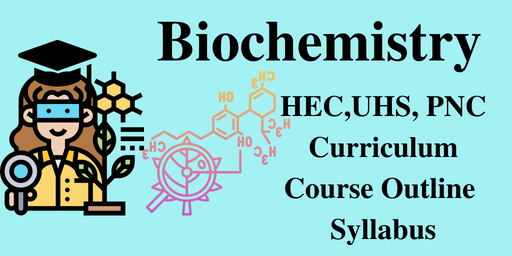Biochemistry HEC Curriculum


Subject Semester Hours
In the 136 Credit hour program ,there 3 hours for Biochemistry.With 2 theory and 1 Lab Credit hours In the "General Courses to be chosen from other departments" Category.
Course Description
This course is intended to provide the health professional with an understanding of the major organic substances of living organisms, proteins, carbohydrates and lipids, their structure analyses and biochemical functions. It also provide an introduction to the chemistry of bioenergetics, metabolism, biosynthesis and molecular biology
Course Objectives
At the end of the course students will be able to: 1. Describe the basics of organic chemistry with emphasis on the biomolecules and reactions encountered in biochemistry of proteins, carbohydrates, lipids, enzymes and hormones. 2. Perform experiment to study the chemical & physical properties of biomolecules. 3. Relate the basic knowledge of biochemistry for better understanding of the physiological functions of the human body.
Bio-Chemistry
|
Sr.No |
Topics |
|
1.
|
Unit:I:Basic concepts of Chemistry Review the basic concepts of matter and elements mixture,
compounds, chemical reactions, equations & bonding. Importance of Chemistry in nursing+Matter+Elements Mixtures &
Compound |
|
2.
|
Structure of Atom (Periodic Table)+Chemical formula+Chemical
Reactions |
|
3.
|
Equations +Bonding +Redox Reaction +Acid Base |
|
4.
|
Uni:II:Basic concepts of Organic Chemistry Definition of Organic Chemistry & Compounds+Classification of
Organic compound |
|
5.
|
Properties of Organic compound+International Union Nomenclature
of Alpha |
|
6.
|
Compounds (IUPAC)+Hydro Carbons |
|
7.
|
Alkanes, Alkene & Alkynes +Isomerism |
|
8.
|
Functional groups +Macromolecule of human body |
|
9.
|
Uit:III: Metabolism and Adeno-Tri-Phosphatase (ATP) Define metabolism, anabolism, catabolism +Define Andensoin
Triphosphalic (ATP) and discuss its relationship with catabolism and
anabolism. |
|
10. |
Define the following terms, gluconeogenesis, glycogenesis,
glycogenolysis, transamination, deamination & ketosis+Briefly discuss the
following metabolic pathways for carbohydrate, protein & fats in terms of
Glycolysis. Kreb cycle & electron transport chain. |
|
11. |
Unit:IV:Chemistry of Carbohydrates Structure of Carbohydrates+Classification of Carbohydrates |
|
12. |
Properties of Carbohydrates+Biological significance of
Carbohydrates |
|
13. |
Unit :V:Chemistry of Lipids Structure of Lipids+Properties of Lipids |
|
14. |
Biological significance of Lipids Classifications of Lipids+1.
Simple lipids +2.Compound Lipids |
|
15. |
Derived Lipids +Fatty Acids
|
|
16. |
Fats & oil+Saturated and unsaturated fatty acids |
|
17. |
Uses of fats in the body+Physical and chemical properties of fats
+Distinguish between soap and detergents+Explain briefly the role of phospholipids
in cell membranes+Role of steroids (cholesterol ) |
|
18. |
Unit:VI:Chemistry of Proteins General chemistry of amino acids+Composition +Amphoteric nature +Essential,nonessential
aminoacids |
|
19. |
Polar, Non polar and zwitter ion+Dipeptides+Structure of Proteins
,Primary,Secondary,Tertiary,Quaternary |
|
20. |
Functions of Proteins+Biological importance of Proteins |
|
21. |
Classification of Proteins on the basis of
,Solubility,Composition,Biological functions |
|
22. |
Properties of Proteins ,Colloidal nature,Denaturation of Protein |
|
23. |
Unit:VII:Nucleic Acid & Nucleotide Review of the cell+Structure of Nucleic acid+Importance of DNA
and RNA |
|
24. |
Chemistry of Nucleic Acid, Nucleosides and Nucleotides+Structure
of DNA & RNA |
|
25. |
Functions of Nucleic Acid+Biological importance of Nucleotides |
|
26. |
Unit:VIII:Enzymology Importance of enzymes+Enzyme as Protein+Properties of Enzymes +Classification,Significance
|
|
27. |
Factors affecting enzyme activity+Enzyme Specificity+Mechanism of
Enzyme action+Activators and inhibitors (compitative+Non
competitive+uncompitative) |
|
28. |
Factors affecting Enzymes
activity,Concentration,Ph,Temperature,Time |
|
29. |
Apoenzymes, coenzymes & co factors+Co-Enzymes & its
classification+Enzymes in clinical medicines |
|
30. |
Unit:IX:Bio-energetics and Metabolism Definition of Bioenergetics,Biogenetic
Metabolism |
|
31. |
Define Bioenergetics Biological+Oxidation,Oxidation,Briefly
discuss the concept of free energy |
|
32. |
Electron transport chain+Explain the role of ATP in Linking
Catabolism and anabolism |
|
33. |
Electron Carriers+Biological Redox Reaction |
|
34. |
Unit X: Metabolism of Carbohydrates Explains the metabolism of CHO,Discuss the importance of glucose
in blood and its dependency by various
|
|
35. |
Discuss the glycogensis and glycogenolysis,Describe the role of
oxidative glucose catabolism in the citric acid cycle. |
|
36. |
Describe the role of gluconeogenesis,Discuss the overall scheme
of carbohydrate metabolism |
|
37. |
Unit:XI:Metabolism of Protein Review the digestion and absorption of Proteins |
|
38. |
Nitrogen balance and its significance+General pathway of Protein
metabolism |
|
39. |
De-amination,De carboxilation, transmissionn + formation of urea
and ammonia disposal |
|
40. |
Unit XI: Metabolism of Fats Describe the mechanism of fatty acid oxidation |
|
41. |
Discuss the amount of energy produced during the oxidation of a
fat. |
|
42. |
Explain the significance of the role of ketone bodies. |
|
43. |
Unit:XIII:Hormones (Communication among cells & tissues) Introduction of hormone+Classes/Classification of Hormones,Steroid
|
|
44. |
Hormone+AminoHormone,Peptide Hormone |
|
45. |
Mode of Action of steroid & peptide hormones+ To become
familiar with the cardiac, pineal and gastrointestinal hormones. |
Lis of Laboratory Practicals
|
Sr.No |
Practical |
|
1. |
First
aid precautions and working in laboratory |
|
2. |
Glass
ware use in laboratory |
|
3. |
Solutions
and their types |
|
4. |
Molischs
test |
|
5. |
Iodine
test |
|
6. |
Benedict
test |
|
7. |
Saliva
test |
|
8. |
Phynylhaydrazine
test |
|
9. |
Millons
test |
|
10. |
Ninhydine
test |
|
11. |
Biuret
test |
|
12. |
Determined
glucose in serum |
|
13. |
Determined
creatinine in serum |




Give your opinion if have any.